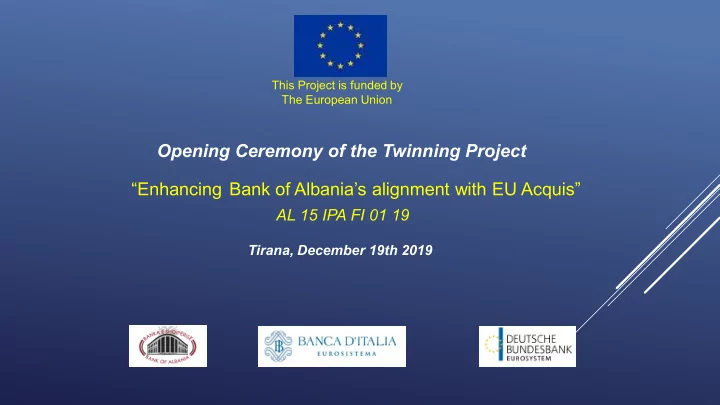

This Project is funded by The European Union Opening Ceremony of the Twinning Project “Enhancing Bank of Albania’s alignment with EU Acquis” AL 15 IPA FI 01 19 Tirana, December 19th 2019
Overview Banca Participative d’Italia partnership Partner Institutions Overall objective Strenghts Institutions Methodology Components
Overall Objective 2019-2020 Strengthening the BoA’s role Integration process By consolidating its capacities and further aligning its legislation still open with EU acquis contributing to the development of operational instruments supporting: Thanks to its reform efforts, Central role of the Bank of • macroeconomic and financial Albania receives the status Albania (BoA) that stability; of candidate country contributes to • a safe, financially sound and macroeconomic stability well-developed banking system In this way, ensuring further advancement in the European Integration Process 2014 (EIP) Aim of the TW Project
Strenghts of the Project Bank of Albania commitment Banca d’Italia strong support Experience and long established relations Collaboration of: Deutsche Bundesbank, Banque de France, and Banca Naţională a României
Track Record of Banca d’Italia Solid experience in Twinning's and ESCB projects Key: EU-funded; involving Albania Strong technical support and commitment to strengthening the BoA Intensive bilateral TC program 2016-18 ESCB/IPA needs analysis (2013) IMF mission (2018)
Member States Partner Institutions Deutsche Banca Naţională Banque de Bundesbank a României France (DB) Junior (BNR) (BdF) Project Leader Highly qualified, with a wide range of experiences and knowledge also in institutional and capacity building projects Germany and France, alongside Italy, are founding member of the EU, with extensive expertise in the implementation of the Union acquis Romania, being a younger EU Member State, owns very recent institutional memories and experiences on the EU accession process
Methodology Banca d’Italia, Deutsche Bundesbank B anca Naţională a României and Banque de France fully commit to : 1. A cooperation based approach : mutual and equal partnership open and constructive dialogue; 2. A participative partnership with the BoA to : encourage ownership maximize the effective transfer of skills and knowledge ensure sustainability; 3. C overage of a large area of central banking and banking supervision activities ; 4. Use of inputs from a large number of experts, in various fields; 5. C ooperation between partners to : take advantage of a full range of experiences, choose the best experts from each NCB , in line with the TW mission and approach .
The Five Components of the Twinning Program 1. Banking supervision and Financial stability 2. Monetary policy and Statistics 3. Internal Auditing 4. Payment systems 5. Other central banking functions Human Resources Department; European Integration Office (EIO)
Twinning Program: some statistics 1 Year program 10 Macro topics 72 Member States Experts 318 Man- Days from Member State Experts 122 Activities (Missions in the BoA and Study visits) of which 110 Missions and 12 Study visits 3 Visibility events 800.000 euros from EU Commission
Twinning Program: Activities and Member States
Component 1 Banking Regulation and Financial Stability 1.1 Basel III and Capital Requirements Directive (CRD IV) and Regulation (CRR) : - Updating guidelines on Internal Models (ICAAP and SREP); stress-testing => capital; - New Standardized Approach under Basel III (various risks); - Accounting standards (IFRS9), for instance accounting for expected credit losses; 1.2 Macro Prudential – Developing a Policy paper based on the European Systemic Risk Board ’s (ESRB) recommendations: - Mitigation of risks arising from the real-estate sector; - Assessment of risks due to the interconnection between banks and non-banks; - Assessment and mitigation of exchange rate risks (“euroization”); - Analysis of the Systemic risk buffer (SyRB): a policy tool for long-term risks (not in CRD)
Component 2 Monetary Policy and Statistics 2.1 A new layout of the Monetary Policy Report: - The aim is to produce a more effective and forward-looking document; - better communicate the monetary policy stance (expectations); - Development of a data warehouse. 2.2 A manual aiming to align the Bank of Albania Monetary statistics and Financial Accounts to the ECB standards: - Frequency of the “flow of funds” and “from-who-to-whom” tables; - Granularity: Instruments; institutional units; valuation of assets; - Use of BSI data for the definition of Minimum reserve requirements.
Component 3 Auditing 3.1 Strengthening the Internal audit capabilities in accordance with the European framework and the International best practices: - Gap analysis to assess the current situation; - Benchmarking best practices; - data analytics and sampling; - Quality control; - Staff training; 3.2 Production of a Policy document more in line with the ECB standards.
Component 4 Payment System 4.1 Payment Account Directive (PAD): gap analysis and roadmap of the implementation; 4.2 Oversight of the Payment system; - PSD2/EBA technical standards on Security of internet payments: strong customer authentication; operational security; incident reporting; fraud reporting. - Cyber-security : operational risks and business continuity; - Oversight of Central Securities Depositories (post-trading infrastructure). 4.3 Technology: possible adaptation of the Albanian Real Time Gross Settlement system (RTGS -AIPS) to the ECB infrastructure (TARGET2); - But also evaluation of different solutions in the area of retail Instant payment infrastructure.
Component 5 Other Central Banking Functions 5.1 New guidelines regarding the activities of the Human Resources department: - Revision of best practices; - Recruitment process; - Implementation of the onboarding activities for the newcomers; - Key performance indicators. 5.2 Enhancing the role of the European Integration Office (EIO) in the Bank of Albania Development of a roadmap in order to improve: - Policy objectives; - Institutional capabilities (organizational setting, resources).
In Conclusion: Sustainable, tangible results for the integration of Albania in the EU Very strong commitment by Member States Full ownership of the Twinning Program by the Bank of Albania
Thank you for your attention ! This project is funded by the European Union
Recommend
More recommend